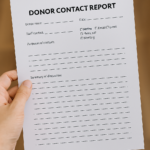Key Components of a Contact Report

In major gift fundraising, every donor interaction is a valuable step toward a meaningful relationship—and the contact report is the permanent record of that step. For philanthropy officers, a well-written contact report does more than capture who said what; it becomes institutional memory, strategic intelligence, and a roadmap for next steps.
Poor or missing contact reports lead to gaps in continuity, lost opportunities, and confusion across teams. Strong, timely reports ensure colleagues, executives, and successors have the information needed to advance the relationship.
Here are the key components every philanthropy officer should include in a contact report after meeting with a prospect:
1. Date, Type, and Format of Contact
Clearly state:
- Date of the meeting
- Contact type: e.g. In-person meeting, Zoom, phone call, event conversation
- Duration of the interaction
- Location: e.g. Prospect’s office, coffee shop, virtual, event venue
This sets the context for the conversation.
2. Participants
List all individuals present, including:
- Internal staff (title and role)
- External attendees (spouse, assistant, peer donor, etc.)
This helps future interactions reflect who was involved in relationship-building.
3. Purpose of the Meeting
Summarise why the meeting was scheduled. Examples:
- Introduction to the organisation
- Program update
- Cultivation touchpoint
- Solicitation conversation
- Stewardship follow-up
Defining the intent shows whether the objective was met.
4. Summary of Discussion
This is the heart of the report. Capture:
- Key points raised by the prospect
- Questions or concerns expressed
- Level of interest in specific initiatives or programs
- Responses to stories, impact updates, or materials shared
Avoid a transcript-style write-up—summarise in clear, concise paragraphs while preserving nuance and tone.
5. Insights Gained
Record what you learned, including:
- Philanthropic motivations
- Capacity and inclination signals
- Personal or professional updates
- Family dynamics
- Preferred communication styles
These details feed into future cultivation and solicitation strategies.
6. Gift Discussion Details (if applicable)
If a gift was discussed, note:
- Amount or range mentioned
- Project/fund of interest
- Timing considerations
- Giving vehicle (e.g. cash, DAF, shares, bequest)
- Recognition preferences or restrictions
Even if the donor was non-committal, document their reactions and hesitations.
7. Donor Sentiment and Readiness
Include a qualitative read:
- Enthusiastic, cautious, distracted, eager, non-committal?
- Any signs of solicitation readiness?
- Any red flags?
This helps calibrate next steps and avoid premature asks.
8. Next Steps
Be explicit about what happens next, including:
- Internal actions (e.g. update proposal, schedule follow-up)
- External steps (e.g. sending a thank-you note, sharing a case for support)
- Assignments (who is doing what by when)
Use bullet points for clarity and accountability.
9. Attachments and Supporting Documents
Mention if you left behind or sent:
- Collateral materials
- Proposals or reports
- Event invitations or other follow-up items
Also include any relevant files uploaded to the CRM.
10. Confidential Notes (Optional, Use Caution)
If needed, add sensitive information that informs future engagement:
- “Donor is selling their business and may be more receptive in 6 months”
- “Expressed dissatisfaction with past CEO—be careful referencing that era”
Use discretion and professionalism; don’t speculate or editorialise.
11. Timely Entry in CRM
Most importantly, enter the contact report into your CRM within 24–48 hours. Delays lead to lost details and lower data quality. The CRM is your organisation’s central memory—don’t keep information siloed in personal notebooks or spreadsheets.
A strong contact report is more than administrative housekeeping—it’s a strategic asset. It protects your organisation’s relationships, ensures continuity, and allows for coordinated, informed fundraising. For philanthropy officers, documenting meetings thoroughly and thoughtfully is a hallmark of professionalism—and one of the simplest ways to build long-term fundraising success.
